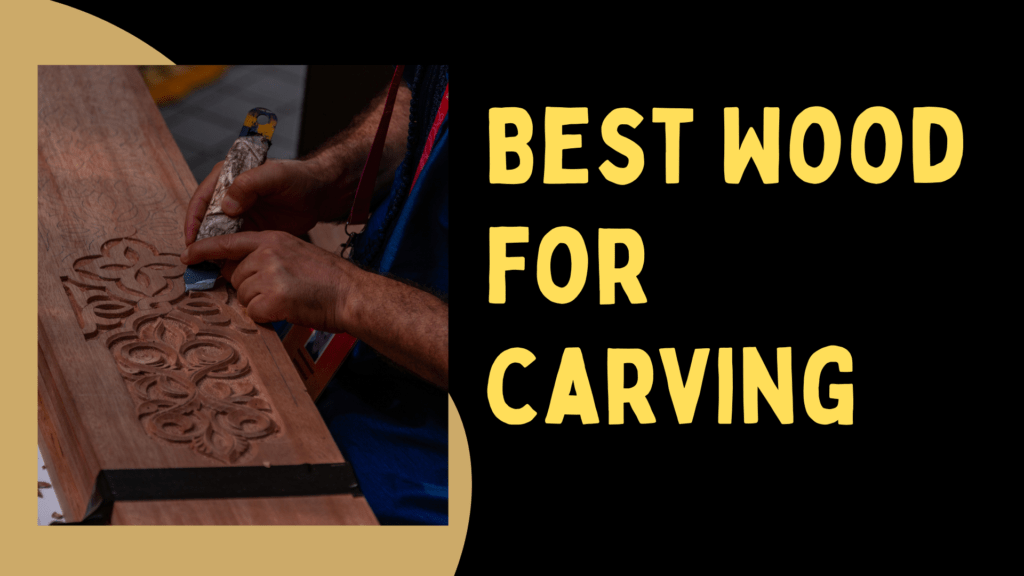
Wood carving is a traditional craft where you shape wood to make beautiful or useful items. You can carve things like sculptures, decorations, spoons, or bowls. But to do a good job, choosing the right wood is very important. The type of wood you pick affects how easy it is to carve and how strong your finished piece will be.
In this guide, we’ll explain the best types of wood for carving, so you can choose the right one for your project.
Types of Wood for Carving
Not all wood is the same. There are two main types you should know about: softwoods and hardwoods. Each type has different qualities like how smooth it is, how it feels when you carve, and how strong it is.
Softwoods
- Come from trees like pine, cedar, and fir.
- Softer and easier to carve—great for beginners.
- Usually lighter and cheaper.
Hardwoods
- Come from trees like oak, maple, and cherry.
- Harder and stronger, but need sharper tools and more effort.
- Good for detailed and long-lasting projects.
Best Softwoods for Carving
Let’s look at some of the most popular softwoods that are great for carving:
Pine – Great for Beginners
Pine is easy to find and very simple to carve. It’s light, soft, and perfect for people who are just starting out. It works best for bigger carvings that don’t need a lot of fine details.
Basswood – A Carver’s Favorite
Basswood is loved by many carvers. It’s smooth, has a very fine grain, and doesn’t splinter much. It’s easy to carve and great for detailed work, making it perfect for more complex designs.
Cedar – Good for Fine Details
Cedar smells nice and is soft to the touch. It carves easily and holds small details well. However, it can be a little more fragile than some other softwoods.
Redwood – Easy and Attractive
Redwood is soft, light, and strong enough to handle carving tools. It has a beautiful reddish color and straight grain, making it a good choice for artistic or decorative carvings.
Best Hardwoods for Carving
Now let’s look at some of the most popular hardwoods that are great for carving:
Maple – A Good All-Round Choice
Maple is strong and long-lasting. It has a smooth texture and is great for carvings with fine details. But because it’s harder than softwoods, it takes more effort to carve.
Oak – Very Strong and Tough
Oak is one of the hardest woods, making it perfect for carvings that need to be strong and last a long time. It has a bold grain pattern and works well for big carvings or useful items like furniture.
Red Oak vs. White Oak: What’s the Difference and Which Is Better?
Cherry – Smooth and Good for Detail
Cherry wood is smooth and easy to work with. It’s great for carving small, detailed pieces. Over time, it darkens and gets a rich, warm color, which makes finished pieces look even better.
Walnut – Rich Color and Beautiful Grain
Walnut is strong but still fairly easy to carve. It’s known for its deep brown color and lovely grain patterns. It’s a great choice for special projects you want to display or keep for a long time.
Comparing Softwoods and Hardwoods
Choosing Between Softwood and Hardwood
Picking the right wood depends on a few things—your skill level, how detailed your project is, and what tools you have.
- Softwoods are easier to carve and are great for beginners. They don’t wear down your tools as quickly.
- Hardwoods are stronger and better for detailed or long-lasting carvings, but they take more time and effort to work with. You’ll also need sharper tools.
In the end, it’s all about what you prefer and what your project needs.
Wood Density and How Easy It Is to Carve
Wood density (how heavy and solid the wood is) affects how easy it is to carve:
Hard, dense woods like oak or walnut are harder to carve but give a smooth and strong finish.
Softer woods like pine are easier to work with, but they may not last as long or hold up as well.
Tips for Choosing the Right Wood
Keep these points in mind when picking wood for carving:
Type of Carving:
- For fine details, go with basswood or cherry.
- For larger or rougher projects, try pine or oak.
Size and Weight:
- Big projects need stronger, heavier woods like oak.
- Small projects can use lighter softwoods.
Wood Grain:
- Look for wood with straight, even grain—it’s easier to carve.
- Avoid wood with knots or twisted grain—it can be tricky and frustrating to carve.
How to Prepare Wood for Carving
Before starting your carving project, it’s essential to prepare your wood. Follow these steps:
Cut and Shape: Use a saw to cut the wood to the desired size and shape.
Sanding: Sand the surface smooth to prevent any splinters or rough spots.
Pre-Treating: Some woods benefit from pre-treatment with oil or wax to prevent cracking as the wood dries.
Common Mistakes to Avoid in Wood Selection
Many beginners make the mistake of choosing the wrong wood for their project. Here are a few things to watch out for:
Choosing Wood with a Poor Grain Pattern: Wood with knots or uneven grain will be much harder to carve.
Ignoring Moisture Content: Wet or damp wood can lead to cracking as it dries.
Underestimating Wood Density: Some hardwoods may be too tough for your tools, especially if you’re just starting.
Wood Care and Maintenance Tips
To ensure your carved pieces last for years, follow these care tips:
Use Wood Finish: A clear finish, like varnish or beeswax, helps protect the surface and brings out the wood’s natural beauty.
Store Properly: Keep your carved pieces in a dry, cool place to prevent cracking or warping.
Avoid Direct Sunlight: Prolonged exposure to sunlight can cause discoloration and drying.
Final Thoughts
Choosing the right wood is very important for a good carving project.
- Softwoods like pine and basswood are perfect for beginners and detailed designs.
- Hardwoods like oak and walnut are stronger and better for advanced work.
Always think about your project type, how detailed it is, and the tools you have before picking your wood.
Frequently Asked Questions (FAQs)
1. What wood is best for beginners?
Pine and basswood are great for beginners because they are soft and easy to carve.
2. Can you carve any type of wood?
Yes, but softwoods are easier to work with, especially for beginners.
3. How do I know if the wood is good for carving?
Pick wood with a straight grain and no knots or twists. Make sure the wood is dry, not wet.
4. Is it better to carve softwood or hardwood?
It depends on your project:
- Softwood is easier to carve, but not as strong.
- Hardwood is stronger, but harder to carve.
5. How do I protect my finished carving?
Apply a wood finish like oil or varnish. Keep your project in a cool, dry place, away from direct sunlight.

